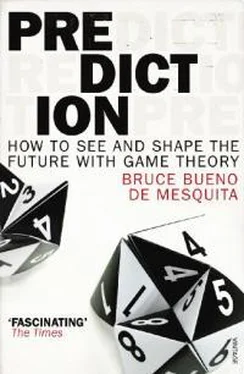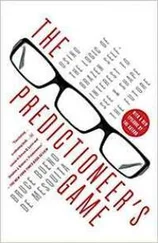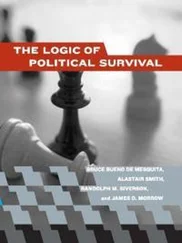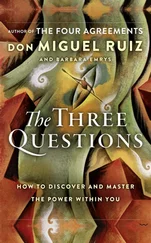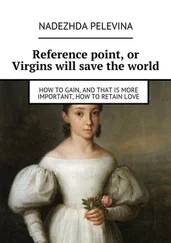Stakeholder
Influence
Price
Salience
Ferdinand
100
0
40
Isabella
70
25
60
Santangel
60
55
75
Columbus
20
100
90
The initial prediction is between 25 (the weighted median voter) and 37 (the weighted mean voter). You can calculate those values yourself from the table. The eventual prediction after the model simulates the bargaining process and its dynamics is for an agreement to be reached at whatever price Luís de Santangel was prepared to offer as long as he was prepared to pay more than Isabella. If Santangel had offered less than Isabella’s price, no deal would have been reached and world history would be quite different. Santangel was no fool. He was a skilled strategist who understood how to persuade and to whom he needed to make his pitch.
In the model’s logic, Santangel first persuades Isabella and then Ferdinand to go along—at no out-of-pocket expense to themselves—and then he negotiates with Columbus. That seems pretty close to what actually happened. Of course, we don’t know how much he was actually prepared to pay, only what he did pay. That’s just the sort of information that my car-buying technique can ferret out, but to use that approach there have to be multiple bidders. Columbus knew—and probably Santangel, Isabella, and Ferdinand did not—that there were no other credible prospective buyers for his plan. So he probably agreed to a lower price than he could have gotten. Too bad Columbus didn’t have a predictioneer available to help him negotiate a better arrangement, but the important thing is that the deal got done.

While the implications of Columbus’s success are pretty apparent to us in the new world, it also had far-reaching consequences for Europe, which provides a nice little segue to our next case, World War I. You see, Ferdinand and Isabella’s great grandson, Philip II, was born in Valladolid and became the Spanish monarch in 1556. Philip was Spain’s king during the defeat of its armada by England in 1588, which laid the groundwork for England’s emergence as a great power and rival to the Spanish empire. Philip also was the King of Portugal, Naples and Sicily, making him one incredibly powerful fellow. He ruled over Spain and its American empire (thanks to Columbus, Luís de Santangel, and Philip’s aunt and uncle), but he also ruled over Austria, Franche-Comté, Milan, Naples, the Netherlands, and Sicily.
And so the success won by Luís de Santangel’s clever maneuvering translated a generation later into binding Spain and Austria together. It also translated into sustained hostility between the French house of Burgundy and Philip’s Habsburg family in Austria and elsewhere. We already know of the tension between Philip’s family and England following the armada. And so, with lots of action along the way, the times of Ferdinand and Isabella had already set the foundation for “the war to end all wars” in 1914.
Let’s have a look at the aftermath of the assassination of the Archduke Franz Ferdinand, heir to the Austro-Hungarian throne. We can use the history of the crisis precipitated by the Archduke’s murder to ask whether the First World War (the European monarchies’ last gasp) was inevitable or could have been avoided. And if it was avoidable, what needed to be done differently? We will use my new forecasting model to address these questions.
AVOIDING WORLD WAR I
The circumstances of World War I paint a truly sad picture. Wars almost always could be avoided if people just knew at the outset what the outcome would be. They can almost always make a deal before fighting starts that leaves both sides better off than is true during and after the war. This is so for the simple reason that whatever costs the combatants bear in fighting, they could avoid bearing while agreeing to the same conclusion as arises at war’s end. The problem is, of course, that each side is unsure at the outset how things will turn out. They bluff about their own strength and resolve in the hope of extracting a really good deal. Much of the time that may work. Wars, especially big wars, are rare events. Sometimes, however, bluffing is tremendously costly. Rather than reveal the truth, governments sometimes fight wars they would have liked to avoid, or at least know too late that they should have avoided. One way contenders in a fight could use predictioneering is to simulate what is likely to happen before the events actually unfold so that they can avoid this very problem, maybe even saving millions of innocent lives as a result.
My new game-theory model (being applied here for the first time) shows a number of ways the First World War could have been avoided. Tens of millions lost their lives because a handful of diplomats played their cards poorly. That is the essence of Greek tragedy in modern times. Before I address how the war might have been avoided, let me provide a brief background on the circumstances that led to it.
Taking a very broad and long view, it is evident that the eighteenth and nineteenth centuries were a time in which those who adopted more democratic forms of government and more capitalist economic modes, such as the Netherlands and England early on and France later, enjoyed burgeoning wealth and influence in the world. Monarchy seemed to be in decline.
Zooming in on the latter half of the nineteenth century, we see the unfolding struggle to control Europe’s destiny. Germany as we know it did not exist for most of the nineteenth century. Instead, modern-day Germany was divided into many princely states—Prussia, Saxony, Baden, Wurttemberg, and many others. Austria dominated German affairs.
All of this was to change with the rise of Otto von Bismarck as Prussia’s minister-president (they certainly went in for awkward titles). Bismarck built Germany into a European power. First he united Prussia with several smaller German princely states to fight the Seven Weeks’ War (1866), in which, to the surprise of most European leaders, he quickly and easily defeated Austria. This war marked the end of the post-Napoleonic Concert of Europe system of checks and balances that had been forged half a century earlier to ensure stability among the great powers of Europe (then consisting of Austria, England, France, Prussia, and Russia) and to prevent the rise of another Napoleon.
The Seven Weeks’ War revealed that Austria was much weaker than its status as a European great power implied. Desperate to maintain itself among the ranks of important states, the Austrian government agreed to a merger with Hungary that resulted in the creation of the Austro-Hungarian Empire. This was the same merger deal that the Austrians had rejected just before their 1866 defeat. The creation of Austria-Hungary helped keep Austria in the running as a great power, slowing but not reversing its declining political position. Just four years later, Bismarck went to war against France, defeating Napoleon III in the Franco-Prussian War of 1870–71. With France’s defeat, Bismarck succeeded in unifying the remaining German princely states, creating modern-day Germany. Whereas Austria had dominated the pre-1866 concept of Germany, it was now excluded, not to be reunited with the rest of Germany until Adolf Hitler—an Austrian by birth—rose to power about sixty years later. By 1871, Bismarck had established Germany as the rising power of Europe and helped France to join Austria (now Austria-Hungary) as a state in decline. This set the stage for the First World War.
Revolutions against monarchy and oligarchy were bubbling up everywhere. There was revolt in Russia in 1905, in Mexico in 1910, and in China in 1911. From the Austro-Hungarian point of view, the most threatening emerging nationalist challenge to monarchy came from the Balkans. There the Austro-Hungarians saw in the experience of the Ottoman Empire the foreshadowing of their own demise. The kingdom of Serbia tripled its territory as a result of the Balkan Wars (1912–13), becoming a magnet for Serbian nationalists. They wanted all of Serbia out of the Austro-Hungarian Empire. Those tensions burst to the surface on June 28, 1914, with the assassination in Sarajevo, today the capital of Bosnia and Herzegovina, of the prospective heir to the Austro-Hungarian throne, Archduke Franz Ferdinand.
Читать дальше
